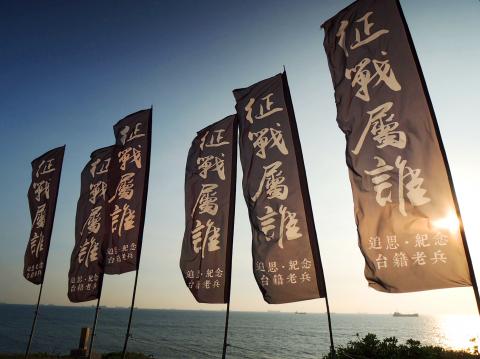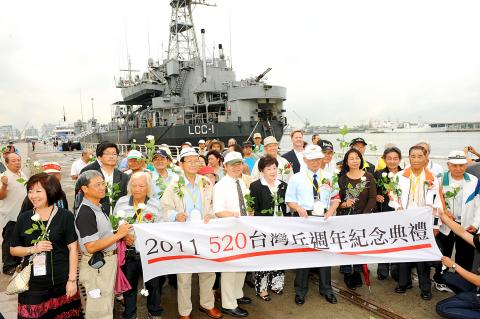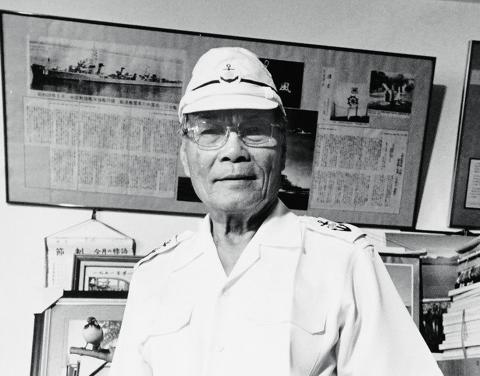Nov. 20 to Nov. 26
They were kept in the dark until the moment of combat.
Chang Teng-hsu (張騰旭) felt uneasy when the Taiwanese soldiers in his squadron were suddenly forbidden from leaving camp in Chiayi. One night, they were woken up and herded onto a train and then a ship.

Photo: Chang Chung-yi, Taipei Times
“They told us we were going to take over a Japanese warehouse in Shanghai,” Chang says. “But we were not treated like soldiers. We were treated like prisoners.”
There was no warehouse. Instead they were instructed to engage in military exercises in a frozen field close to Shanghai in a place called Xuzhou, only to find out that it wasn’t a drill when the Communist guerillas struck.
Similar tales flooded the Legislative Yuan in April 1994 during a public hearing for Taiwanese veterans who were sent to China to fight for the Chinese Nationalist Party (KMT) during the Chinese Civil War. Many of them perished in battle or were taken prisoner by the People’s Liberation Army (PLA), and only about 500 soldiers made it safely back to Taiwan. The remaining 1,500 survivors were stranded in China after the KMT retreat in 1949.

Photo: Wang Jung-hsiang, Taipei Times
It would be another 38 years before Hsieh Yuan-pa (謝源拔) would see his homeland again. On Nov. 22, 1988, he became the first Taiwanese veteran in China approved by Taiwan authorities to return home and visit his ailing mother.
“Besides ‘mom,’ I had forgotten how to speak Hakka,” Hsieh tells Taisheng (台聲) magazine. “My mother only knew Hakka; she couldn’t even speak basic Mandarin. All I could do was cry in her lap like a child.”
TRICKED INTO WAR

Photo: Chang Chung-yi, Taipei Times
While Taiwan was exempt from the draft during the Chinese Civil War, many Taiwanese joined the KMT army. Some desired a better living, some were tricked or forced into joining while others were members of the Japanese army that the KMT inherited at the end of World War II.
A 1946 recruitment speech recorded in the Taiwan Shin Sheng Pao (台灣新生報) newspaper promised that Taiwanese soldiers would not be deployed outside of Taiwan. Many soldiers did not know they were to fight the Communists until they landed in China, and did not get to say goodbye to their family.
Hsu Chao-jung (許昭榮), a veteran who spent 30 years fighting for these soldiers’ honor and rights, estimates that around 15,000 fought in China.

Photo courtesy of Wikimedia Commons
Tseng Hsueh-yu (曾學佑) writes in the study, The Heartbreaking Story of Taiwanese Soldiers (台籍國軍血淚史), that PLA prisoners who came from Communist-controlled areas were allowed to go home, but since Taiwan was under KMT control, these soldiers were often conscripted.
Huang A-jui (黃阿瑞) says in an Academia Historica oral history publication that after the war, he was sent to military school to prepare for an invasion of Taiwan until plans were cut short by the outbreak of the Korean War. The Communists didn’t fully trust the Taiwanese, so instead of sending him to war, Huang was given a position with the Zhangzhou City Government. He settled there, married and had children. There were a handful who did see combat in Korea, Tseng writes.
Hsu Teng-kuang (徐騰光) was captured during the Huaihai Campaign, a decisive battle that determined the outcome of the Chinese Civil War. He refused to join the PLA, so they trained him for a future government post in Taiwan after its “liberation.” That never happened, and Hsu settled in Suzhou.
These soldiers suffered greatly over the decades, easy targets as “traitors,” “rightists” and “anti-revolutionaries” for having been Japanese citizens during colonial rule, as well as having once served the KMT when the Japanese left. During the Cultural Revolution, Hsu was accused of being an “international spy” and spent eight months in jail, during which the Red Guards ransacked his property and stopped his son from going to school and his wife going to work.
They were rehabilitated by Chinese leader Deng Xiaoping (鄧小平) in 1978.
INJUSTICE AT HOME
In 1996, Hsu Teng-kuang returned home for good with his family in tow. The government compensated him NT$850,000 and gave him a monthly allowance of NT$14,000, but Hsu says he had to work at a factory and collect cans on the street to make ends meet. He found it unfair that he didn’t receive a pension like other veterans.
In fact, the government initially only provided a one-time fee of NT$15,000 until protests in 1996 forced them to pay up.
Officially discharged in 1997, Huang tried to collect back wages from the government only to be turned down. An editorial in the Central Daily News branded him communist who did not deserve compensation. Others lost their property rights since they were declared dead, ending up with no place to stay.
In addition, not everyone was able to visit Taiwan due to the government’s strict requirements. They also did not receive the NT$20,000 fee provided to all Chinese soldiers stranded in Taiwan to visit China.
“How do I get those 40 years back? We were tricked into the battlefield and robbed of our entire future. Who will give us justice?” Chang Teng-hsu says.
Hsu Chao-jung, one of the lucky ones to make it back to Taiwan after the war, could bear it no longer. He was never a complacent person, having spent more than a decade in jail for disseminating a Taiwan independence publication and later blacklisted for participating in an anti-KMT march while on business in Los Angeles. He received asylum in Canada.
In 1987, Hsu started tracking down the whereabouts of his former comrades, locating 18 in China in two months with the help of a Chinese journalist. He contacted the press and word spread. He first started campaigning for them in China, and continued in Taiwan after he was removed from the blacklist in 1991.
“I don’t know if I’m lucky or unlucky to have been in exile in Canada, otherwise I wouldn’t have found out about the soldiers stranded in China. Perhaps it’s a mission given to me by my dead comrades,” he writes in Blood and Tears of the Taiwanese Veterans (台籍老兵的血淚故事).
The first battle was to fight for veteran status, and then for more compensation. But the government never budged after its 1996 offer. They provided Hsu with land to build a memorial, but offered no further assistance.
Frustrated, Hsu used his own funds to erect a temporary monument in 2000. In 2004, Hsu discovered that the government had other plans for the site, forcing him to use the last of his money and donations to complete the memorial.
Hsu etched his anger onto the monument: “The Ministry of Defense still does not admit our existence. The KMT avoided responsibility for 60 years, and now the ruling Democratic Progressive Party acts as if it isn’t their responsibility either.”
The government finally helped in 2005, establishing the War and Peace Memorial Park in 2006 and holding the first government-sponsored ceremony in 2007.
Just a year later, the government proposed to change the name of the park and remove the stele at the entrance. On May 20, 2008, Hsu set himself on fire in front of the monument. He blasted the government in his final note, vowing to protect the park until his death.
Hsu got his wish on the anniversary of his death, when the government paid to build a memorial and a museum commemorating all Taiwanese who died in battle.
Taiwan in Time, a column about Taiwan’s history that is published every Sunday, spotlights important or interesting events around the nation that have anniversaries this week.

Following the shock complete failure of all the recall votes against Chinese Nationalist Party (KMT) lawmakers on July 26, pan-blue supporters and the Chinese Communist Party (CCP) were giddy with victory. A notable exception was KMT Chairman Eric Chu (朱立倫), who knew better. At a press conference on July 29, he bowed deeply in gratitude to the voters and said the recalls were “not about which party won or lost, but were a great victory for the Taiwanese voters.” The entire recall process was a disaster for both the KMT and the Democratic Progressive Party (DPP). The only bright spot for

Water management is one of the most powerful forces shaping modern Taiwan’s landscapes and politics. Many of Taiwan’s township and county boundaries are defined by watersheds. The current course of the mighty Jhuoshuei River (濁水溪) was largely established by Japanese embankment building during the 1918-1923 period. Taoyuan is dotted with ponds constructed by settlers from China during the Qing period. Countless local civic actions have been driven by opposition to water projects. Last week something like 2,600mm of rain fell on southern Taiwan in seven days, peaking at over 2,800mm in Duona (多納) in Kaohsiung’s Maolin District (茂林), according to

Aug. 11 to Aug. 17 Those who never heard of architect Hsiu Tse-lan (修澤蘭) must have seen her work — on the reverse of the NT$100 bill is the Yangmingshan Zhongshan Hall (陽明山中山樓). Then-president Chiang Kai-shek (蔣介石) reportedly hand-picked her for the job and gave her just 13 months to complete it in time for the centennial of Republic of China founder Sun Yat-sen’s birth on Nov. 12, 1966. Another landmark project is Garden City (花園新城) in New Taipei City’s Sindian District (新店) — Taiwan’s first mountainside planned community, which Hsiu initiated in 1968. She was involved in every stage, from selecting

As last month dawned, the Democratic Progressive Party (DPP) was in a good position. The recall campaigns had strong momentum, polling showed many Chinese Nationalist Party (KMT) lawmakers at risk of recall and even the KMT was bracing for losing seats while facing a tsunami of voter fraud investigations. Polling pointed to some of the recalls being a lock for victory. Though in most districts the majority was against recalling their lawmaker, among voters “definitely” planning to vote, there were double-digit margins in favor of recall in at least five districts, with three districts near or above 20 percent in